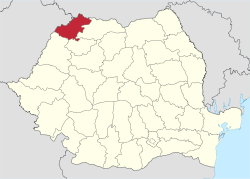Satu Mare (county)
|
Satu Mare County Județul Satu Mare |
||
|---|---|---|
| County | ||
|
||
 |
||
| Coordinates: 47°41′N 22°53′E / 47.69°N 22.89°ECoordinates: 47°41′N 22°53′E / 47.69°N 22.89°E | ||
| Country | Romania | |
| Development region | Nord-Vest | |
| Historical region | Crișana, Maramureș | |
| Capital | Satu Mare | |
| Area | ||
| • Total | 4,418 km2 (1,706 sq mi) | |
| Area rank | 36th | |
| Population (2007) | ||
| • Total | 366,270 | |
| • Rank | 31st | |
| • Density | 83/km2 (210/sq mi) | |
| Telephone code | (+40) 261 or (+40) 361 | |
| ISO 3166 code | RO-SM | |
| Website |
County Council Prefecture |
|
Satu Mare County (Romanian: Județul Satu Mare, pronounced [ˌsatu ˈmare]) is a county (județ) of Romania on the border with Hungary and Ukraine. The capital city is Satu Mare. Besides Romanians (58.8% of the population), Satu Mare features a significant ethnic minority of Hungarians (35.2%).
In Hungarian, it is known as Szatmár megye, in German as Kreis Sathmar, in Ukrainian as Сату-Маре, and in Slovak as Satmárska župa.
Satu Mare is a multicultural city, with a population mix of Romanian, Hungarian, Roma, German and other ethnicities.
In 2002, Satu Mare County had a population of 367,281 and the population density was 83/km².
In 2011, its population was 329,079 and population density was 74.48/km².
Hungarians mostly reside along the border with Hungary, but some are also scattered throughout the whole county.
Historically, Hungarians were concentrated in the cities, where administration resides, while the Romanian population was larger in the villages throughout the county. In 1930 the Hungarians were representing 41,9% of the urban population in Satu Mare County and only 20,0% of the population in the villages according to census data. The proportion of different ethnic groups varied throughout the history, due to regime and political changes. After the Austro-Hungarian Compromise of 1867 the Hungarian population increased its proportion greatly, in 1880 representing 44.4% and in 1910 reaching 55.1% of the county population, according to Árpád E. Varga. After World War I the Hungarian and German population declined.
...
Wikipedia

